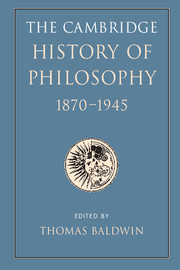Book contents
- Frontmatter
- Contents
- List of contributors
- Introduction
- I 1870–1914
- II 1914–1945
- 8 Logic and philosophy: the analytic programme
- 9 The diversity of philosophy
- 10 Knowledge, language, and the end of metaphysics
- 11 Philosophy and the exact sciences
- 12 Mind and its place in nature
- 13 Philosophy and social science
- 14 Ethics, religion, and the arts
- 58 From intuitionism to emotivism
- 59 Philosophy of religion
- 60 Literature as philosophy
- 61 Aesthetics between the wars: art and liberation
- 15 Law and politics
- Biobibliographical appendix
- Bibliography
- INDEX
- References
61 - Aesthetics between the wars: art and liberation
from 14 - Ethics, religion, and the arts
Published online by Cambridge University Press: 28 March 2008
- Frontmatter
- Contents
- List of contributors
- Introduction
- I 1870–1914
- II 1914–1945
- 8 Logic and philosophy: the analytic programme
- 9 The diversity of philosophy
- 10 Knowledge, language, and the end of metaphysics
- 11 Philosophy and the exact sciences
- 12 Mind and its place in nature
- 13 Philosophy and social science
- 14 Ethics, religion, and the arts
- 58 From intuitionism to emotivism
- 59 Philosophy of religion
- 60 Literature as philosophy
- 61 Aesthetics between the wars: art and liberation
- 15 Law and politics
- Biobibliographical appendix
- Bibliography
- INDEX
- References
Summary
The arts after the First World War, especially in the 1920s, were a scene of tremendous innovation and experimentation: in the visual arts, there was Dada, Surrealism, Constructivism, Futurism, Neue Sachlichkeit, and more, while a previously radical artist like Picasso at least seemed to be taking a step backwards with neo-classicism; in literature, John Dos Passos experimented with visual techniques like collage and newsreel while James Joyce experimented with stream-of-consciousness; in music, the atonal principles of the Vienna school (Schönberg, Berg, and Webern) clashed with the neo-classicism of Stravinsky (another former radical who seemed to be returning to the past), Bartok turned to folk music for inspiration, and in America the influence of jazz blurred the boundaries between popular and high art; in architecture, mysticism and industrialism battled for the soul of the Bauhaus, while Frank Lloyd Wright reinvented himself, transforming his earlier naturalism of wood, brick, and stone into a dazzling new geometry of glass and concrete; and much of this ferment was inspired by political upheaval in Germany and Russia and scientific upheaval in the form of Einstein’s theory of relativity, quantum physics, and above all Sigmund Freud’s discovery of the subconscious and the all-pervasive sexuality of the human psyche.
At one level, much of this seems to have passed academic aesthetics by. Although prewar aestheticians had seemed bent on making room for modern art with their de-emphasis of beauty and insistence on the possibility of the difficult and ugly, many of the leading aestheticians of the interwar period seemed to have little to say about artistic experimentation. For instance, the invention of conceptual art by Marcel Duchamp in the ’teens didn’t seem to make much of an impression on aestheticians until Arthur Danto’s famous paper on ‘The Artworld’ in 1964 (Danto 1964) although since then much in aesthetics has concerned little else but the definition of art supposedly thrown into question by such work as Duchamp’s.
- Type
- Chapter
- Information
- The Cambridge History of Philosophy 1870–1945 , pp. 721 - 736Publisher: Cambridge University PressPrint publication year: 2003



